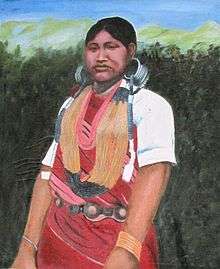Hill Miri people

The Nyishis are a people of Arunachal Pradesh, India.[1] They are mainly settled in kurung kumey,kara dadii,east kameng,papum pare,lower subansiri and partly in [Upper Subansiri District]. The Nyishis are the most populated tribes of arunachal Pradesh, estimated at 3,00,000,[2] because of which they were officially recognise as one of the major tribe along with adis and galos.They speak the Tibeto-Burman language of India.Nyishi share common descendant/lineage from ringdo, i.e., Dopum, Dodum, Dol/Dolu.
The main festivals are Nyokum yullo,longte yullo and Boori-Boot yullo, celebrated on 26th,15th and 6th February respectively. The rituals are carried out by the community priests (Nyub/Nyubu) which includes chanting of hymns and sacrificing animals like mithun (Sobe/sebe), goats, chickens,pig etc., and also serving of local beer (Opo) among the people,except in case of longte yullo,where there is no sacrifice of animals.
The traditional attire of male include Lenin cloth wrapped over the body covering the upper portion of the body up to the knees, headgear includes a cap(bopar/bopa/bopia) made of cane ropes which has a strap of bear skin attached anteriorly(sometimes fitted with hornbill beak at the top).The male carry a long sword (orok/oriok) and a small knife (rwchik/rwuchuk) under a bamboo cover fastened to a rope which he prefers to carry along with him. The female dress includes blouse and a long cloth (gale) wrapped around the waist with beautiful piece of hand-made art knitted on it. The Nyishi are agriculturist and they primarily grow crops like rice, millet,and vevetables. The mode of cultivation preferably practiced is Jhum Cultivation. They grow millets especially to prepare local wine (Opo), also made from the local rice, which is very much loved by the people. The wine is served in plenty during special occasions like festival, marriage, parties etc.